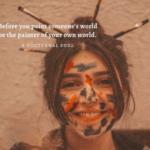The artwork in the picture is titled “Dialogue between the Egyptian Pharaoh and the Shang King,” created by Taiwanese calligrapher Lu He-Song. This piece uniquely combines China’s Shang Dynasty “oracle bone script” with ancient Egypt’s “hieroglyphs.” Can you distinguish between the two?

Recently, the “Xingqi Collection – 2024 Lu He-Song and Chinese Oracle Bone Script Art Association Calligraphy Exhibition” (September 14, 2024 – October 20, 2024) is being held at the Art Center of National Chung Hsing University (Taichung City, Taiwan). The exhibition features not only traditional “oracle bone script calligraphy” but also seal carving, painting, sculpture, and craft works, making it a must-see.

As is well known, oracle bone script is one of the earliest systematic forms of writing in China, primarily used for divination records during the late Shang Dynasty (circa 1600-1046 BCE). These characters were usually inscribed on turtle shells or animal bones, hence the name “oracle bone script.”
The oracle bone script site “Yinxu” was excavated in the late Qing Dynasty during the reign of Emperor Guangxu (1875-1908). The inscribed turtle shells and ox bones were discovered as late as 1899 by Qing Dynasty official Wang Yirong.
This discovery has significant implications for the study of ancient Chinese history and paleography, leading to the establishment of “oracle bone studies” as a field of ancient script research. Currently, about 5,000 oracle bone characters have been discovered, but only around 2,000 can be recognized and interpreted.
In this cross-disciplinary exhibition of writing and art, the exhibited works strive to highlight the characteristics of oracle bone script’s “engraving” and the artistic expressiveness of its lines. The ancient, often unrecognizable characters are used as a medium in seal carving, painting, sculpture, and craft works, incorporating “oracle elements” to create a new “artistic appearance.” This approach balances the traditional significance of calligraphy art with the creative aspects of painting.
Lu He-Song, the honorary founding president of the Chinese Oracle Bone Script Art Association, created the piece “Dialogue between the Egyptian Pharaoh and the Shang King” (as shown in the picture), seamlessly integrating oracle bone script with ancient Egyptian hieroglyphs to create a unique and impressive work.
Ancient Chinese oracle bone script was engraved on turtle shells and animal bones, while ancient Egyptian hieroglyphs were inscribed on stone, wood, and papyrus. Oracle bone script is more abstract and ideographic, while Egyptian hieroglyphs consist of ideograms, phonograms, and determinatives, featuring both pictorial and abstract symbols. Oracle bone script reflects ancient Chinese religious beliefs and social structure, whereas Egyptian hieroglyphs depict ancient Egyptian religion, politics, and daily life.
Lu He-Song’s ability to harmoniously combine these two distinct writing systems into a single artwork is truly ingenious and awe-inspiring. This exhibition, “Xingqi Collection – 2024 Lu He-Song and Chinese Oracle Bone Script Art Association Calligraphy Exhibition,” clearly aims to innovate and advance, making it highly commendable.
https://youtu.be/TljWLIw9wcY?si=InIxaba7I38WH2z2







